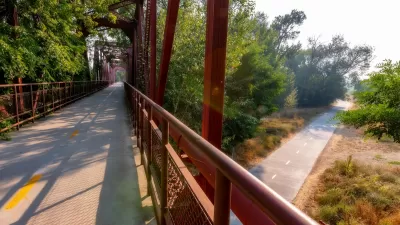If you've always thought that the primary way to encourage more bicycling in your city was simply to build more bike lanes and bike paths, you'll be happy to read about a new study that finally proves your point.
Brad Plumer reports on the simple math reported in a new study [PDF] published in the journal Transport Policy, that proves the single most important factor in encouraging cyclists is the creation of bike lanes and bike paths. Ralph Buehler and John Pucher, authors of the study, "found that the presence of off-road bike paths and on-street bike lanes were, by far, the biggest determinant of cycling rates in cities. And that's true even after you control for a variety of other factors like how hot or cold a city is, how much rain falls, how dense the city is, how high gas prices are, the type of people that live there, or how safe it is to cycle," reports Plumer.
By the way, you're not the only one who thought this equation seemed pretty obvious. However, as Plumer writes, "the authors do note that previous research was somewhat scattered on this question. A few studies had found that more bike lanes in a city were associated with more cycling, though it was unclear which was causing which. Perhaps cities were building bike lanes because they already had a group of devoted cyclists."
Buehler and Pucher seem to have finally settled the question.
FULL STORY: Want more bikers? Build more bike lanes.

Alabama: Trump Terminates Settlements for Black Communities Harmed By Raw Sewage
Trump deemed the landmark civil rights agreement “illegal DEI and environmental justice policy.”

Study: Maui’s Plan to Convert Vacation Rentals to Long-Term Housing Could Cause Nearly $1 Billion Economic Loss
The plan would reduce visitor accommodation by 25% resulting in 1,900 jobs lost.

Why Should We Subsidize Public Transportation?
Many public transit agencies face financial stress due to rising costs, declining fare revenue, and declining subsidies. Transit advocates must provide a strong business case for increasing public transit funding.

Wind Energy on the Rise Despite Federal Policy Reversal
The Trump administration is revoking federal support for renewable energy, but demand for new projects continues unabated.

Passengers Flock to Caltrain After Electrification
The new electric trains are running faster and more reliably, leading to strong ridership growth on the Bay Area rail system.

Texas Churches Rally Behind ‘Yes in God’s Back Yard’ Legislation
Religious leaders want the state to reduce zoning regulations to streamline leasing church-owned land to housing developers.
Urban Design for Planners 1: Software Tools
This six-course series explores essential urban design concepts using open source software and equips planners with the tools they need to participate fully in the urban design process.
Planning for Universal Design
Learn the tools for implementing Universal Design in planning regulations.
Caltrans
Smith Gee Studio
Institute for Housing and Urban Development Studies (IHS)
City of Grandview
Harvard GSD Executive Education
Toledo-Lucas County Plan Commissions
Salt Lake City
NYU Wagner Graduate School of Public Service




























